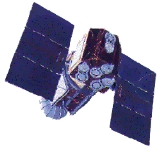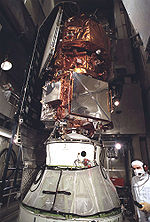
Extreme Ultraviolet Explorer
Encyclopedia
The Extreme Ultraviolet Explorer (EUVE) was a space telescope for ultraviolet
(UV) astronomy
, launched on June 7, 1992. With instruments for UV radiation between wavelengths of 7 and 76 nm, the EUVE was the first satellite mission especially for the short-wave ultraviolet range. The satellite compiled an all-sky survey of 801 astronomical targets before being decommissioned on January 31, 2001. It re-entered the atmosphere on January 30, 2002.

Ultraviolet
Ultraviolet light is electromagnetic radiation with a wavelength shorter than that of visible light, but longer than X-rays, in the range 10 nm to 400 nm, and energies from 3 eV to 124 eV...
(UV) astronomy
Astronomy
Astronomy is a natural science that deals with the study of celestial objects and phenomena that originate outside the atmosphere of Earth...
, launched on June 7, 1992. With instruments for UV radiation between wavelengths of 7 and 76 nm, the EUVE was the first satellite mission especially for the short-wave ultraviolet range. The satellite compiled an all-sky survey of 801 astronomical targets before being decommissioned on January 31, 2001. It re-entered the atmosphere on January 30, 2002.

Mission goals
The goals of the mission included several different areas of observation using the extreme ultraviolet (EUV) range of frequencies:- To make an all-sky survey in the extreme ultraviolet band
- To make a deep survey in the EUV range on two separate bandpasses
- To make spectroscopic observations of targets found by other missions
- To observe EUV sources such as hot white dwarfs and coronal stars
- To study the composition of the interstellar medium using EUV spectroscopy
- To determine whether it would be beneficial to create another, more sensitive EUV telescope

